 Since the new version of Configuration Manager, Forefront Endpoint Protection has become a full class citizen of Configuration Manager 2012 and has been renamed to System Center 2012 Endpoint Protection. In an earlier blog I already wrote about the functionality, in this blog I will mention all the out of the box policy templates that come with Endpoint Protection 2012 and how to import them.
Since the new version of Configuration Manager, Forefront Endpoint Protection has become a full class citizen of Configuration Manager 2012 and has been renamed to System Center 2012 Endpoint Protection. In an earlier blog I already wrote about the functionality, in this blog I will mention all the out of the box policy templates that come with Endpoint Protection 2012 and how to import them.
Like mentioned in the blog about the anti-virus exclusions for Configuration Manager 2012, Endpoint Protection comes with 25 template that can be imported into Configuration Manager. You can use these templates by importing them and deploying them to a collection.
To import these template go to the Assets and Compliance workspace and select the Endpoint Protection node. Right click this node and select Import.
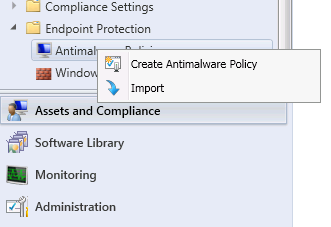
Browse to the template you want to import and click on Open.
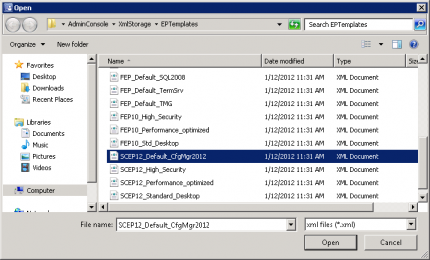
The template will be imported and before saving it you can change settings if you like.
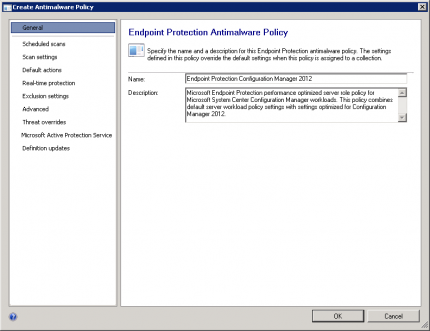
The next step is to deploy these antimalware policies to a collection.
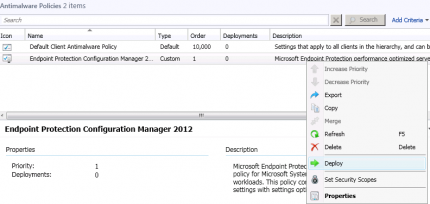
As we selected the Configuration Manager 2012 policy template, we need to deploy the policy to a custom created collection called Configuration Manager 2012 Servers.
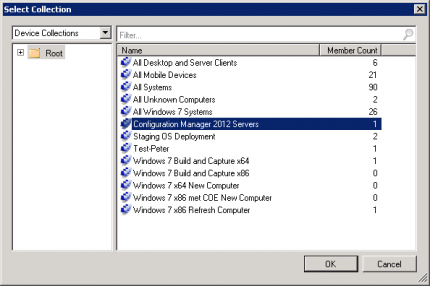
The Endpoint Protection 2012 templates can be found at the following location;
<drive>Program FilesMicrosoft Configuration ManagerAdminConsoleXmlStorageEPTemplates
As mentioned, System Center 2012 Endpoint Protection comes with 25 Antimalware Policy templates, see the complete list below.
| Filename | Description |
| FEP10_High_Security.xml SCEP12_High_Security.xml |
High security policy for Windows based systems. |
| FEP10_Performance_optimized.xml SCEP12_Performance_optimized.xml |
Performance optimized policy for Windows based systems. |
| FEP10_Std_Desktop.xml SCEP12_Std_Desktops.xml |
Performance optimized policy for Windows desktop systems. |
| FEP_Default_CfgMgr2007.xml | Performance optimized server role policy for Microsoft System Center Configuration Manager workloads. This policy combines default server workload policy settings with settings optimized for Configuration Manager 2007 and Configuration Manager 2007 R2. |
| FEP_Default_DC.xml | Performance optimized server role policy for Active Directory domain controller workloads. This policy combines default server workload policy settings with settings optimized for domain controllers. This policy is applicable to domain controllers running on Windows Server 2003, Windows Server 2003 R2, Windows Server 2008 and Windows Server 2008 R2. |
| FEP_Default_DHCP.xml | Performance optimized server role policy for DHCP server workloads. This policy combines default server workload policy settings with settings optimized for DHCP servers. This policy is applicable to DHCP servers running on Windows Server 2003, Windows Server 2003 R2, Windows Server 2008 and Windows Server 2008 R2. |
| FEP_Default_DNS.xml | Performance optimized server role policy for DNS server workloads. This policy combines default server workload policy settings with settings optimized for DNS servers. This policy is applicable to DNS servers running on Windows Server 2003, Windows Server 2003 R2, Windows Server 2008 and Windows Server 2008 R2. |
| FEP_Default_Exchange.xml | Performance optimized server role policy for Microsoft Exchange Server workloads. This policy combines default server workload policy settings with settings optimized for Exchange Server 2007 and Exchange Server 2010. |
| FEP_Default_Exchange_FPE.xml | Performance optimized server role policy for Microsoft Exchange Server workloads protected by Microsoft Forefront Protection 2010 for Exchange Server (FPE). This policy combines default server workload policy settings with settings optimized for Microsoft Exchange Server 2007 and Microsoft Exchange Server 2010 and FPE. |
| FEP_Default_File.xml | Performance optimized server role policy for file server workloads. This policy combines default server workload policy settings with settings optimized for file servers. This policy is applicable to file servers running on Windows Server 2003, Windows Server 2003 R2, Windows Server 2008 and Windows Server 2008 R2. |
| FEP_Default_HyperV_Host.xml | Performance optimized server role policy for Microsoft Hyper-V host server workloads. This policy combines default server workload policy settings with settings optimized for Hyper-V host servers. This policy is applicable to Hyper-V running on Windows Server 2008 and Windows Server 2008 R2. |
| FEP_Default_IIS.xml | Performance optimized server role policy for Internet Information Server (IIS) workloads. This policy combines default server workload policy settings with settings optimized for IIS 6 and IIS 7. This policy is applicable to IIS servers running on Windows Server 2003, Windows Server 2003 R2, Windows Server 2008 and Windows Server 2008 R2. |
| FEP_Default_OCS.xml | Performance optimized server role policy for OCS workloads. This policy combines default server workload policy settings with settings optimized for IIS, SQL 2008 and OCS. This policy is applicable to OCS servers running on Windows Server 2003, Windows Server 2003 R2, Windows Server 2008 and Windows Server 2008 R2. |
| FEP_Default_OpsMgr2007.xml | Performance optimized server role policy for Microsoft System Center Operations Manager workloads. This policy combines default server workload policy settings with settings optimized for Operations Manager 2007 and Operations Manager 2007 R2. |
| FEP_Default_Server.xml | server role policy for general server workloads. This policy is not optimized for any particular server workload. This policy is applicable to servers running Windows Server 2003, Windows Server 2003 R2, Windows Server 2008 and Windows Server 2008 R2. |
| FEP_Default_SharePoint.xml | Performance optimized server role policy for Windows SharePoint Services workloads. This policy combines default server workload policy settings with settings optimized for SharePoint 2010. |
| FEP_Default_SharePoint_FPSP.xml | Performance optimized server role policy for Microsoft Windows SharePoint Services workloads protected by Microsoft Forefront Protection 2010 for SharePoint Server (FPSP). This policy combines default server workload policy settings with settings optimized for SharePoint 2010 and FPSP. |
| FEP_Default_SQL2005.xml | Performance optimized server role policy for Microsoft SQL Server 2005 workloads. This policy combines default server workload policy settings with settings optimized for SQL servers. |
| FEP_Default_SQL2008.xml | Performance optimized server role policy for Microsoft SQL Server 2008 workloads. This policy combines default server workload policy settings with settings optimized for SQL servers. |
| FEP_Default_TermSrv.xml | Performance optimized server role policy for Terminal Server workloads. This policy combines default server workload policy settings with settings optimized for terminal servers. This policy is applicable to terminal servers running on Windows Server 2003, Windows Server 2003 R2, Windows Server 2008 and Windows Server 2008 R2. |
| FEP_Default_TMG.xml | Performance optimized server role policy for Microsoft TMG Server workloads. This policy only contains settings optimized for TMG servers. |
| SCEP12_Default_CfgMgr2012.xml | Performance optimized server role policy for Microsoft System Center Configuration Manager workloads. This policy combines default server workload policy settings with settings optimized for Configuration Manager 2012. |



Dear Peter,
do you know anything regarding the problem that after apply sp1 only antimalware policy was apply to endpoint?
Hi Zeno, no I did not have this issue. Do you see anything in the logs?
If it stays there, you can submit some feedback at the connect site.
Hy Peter…. No access to Connect site…. I post on forefront blog and SCCM blog.
Rick Tan said that ms knows it, but no info yet
This is the post
http://social.technet.microsoft.com/Forums/en-US/FCSNext/thread/4ff3da21-03bb-4a75-b85c-6090c1f03375
Hi Peter,
Just wanted to let you and your readers know that there is now a SCCM Console Extension that adds a “Removable Media Policies” (i.e. USB drives, smartphones, tablets, SD-Cards, CD/DVD) node to the existing SCCM “Endpoint Protection” folder. You can watch a video at http://www.youtube.com/watch?v=IDhltKj93j0. This extension is from a Microsoft System Center ISV partner called Squadra Technologies.
Hi Anthony,
Do you have nfr licenses so that I am able to test this?
Cheers,
Peter